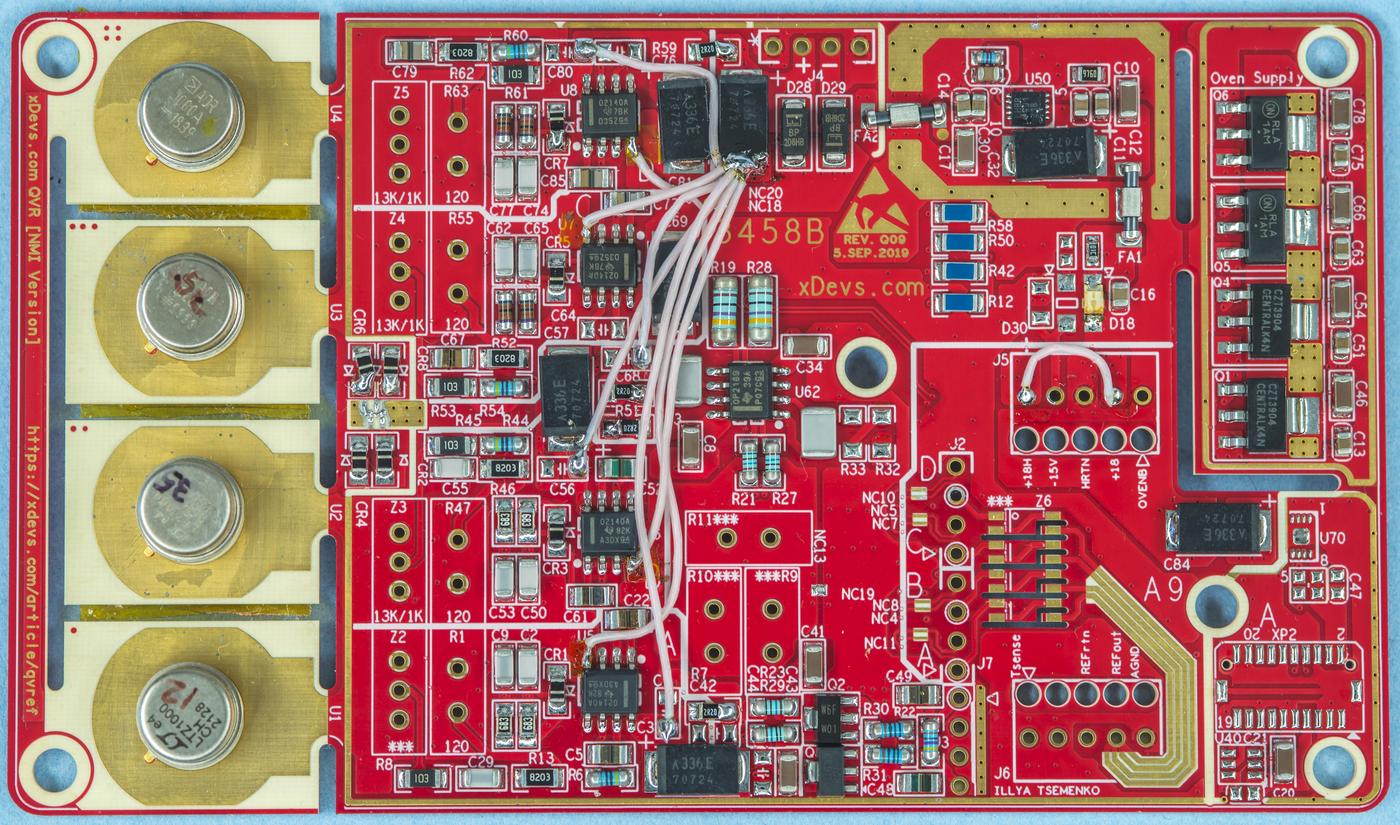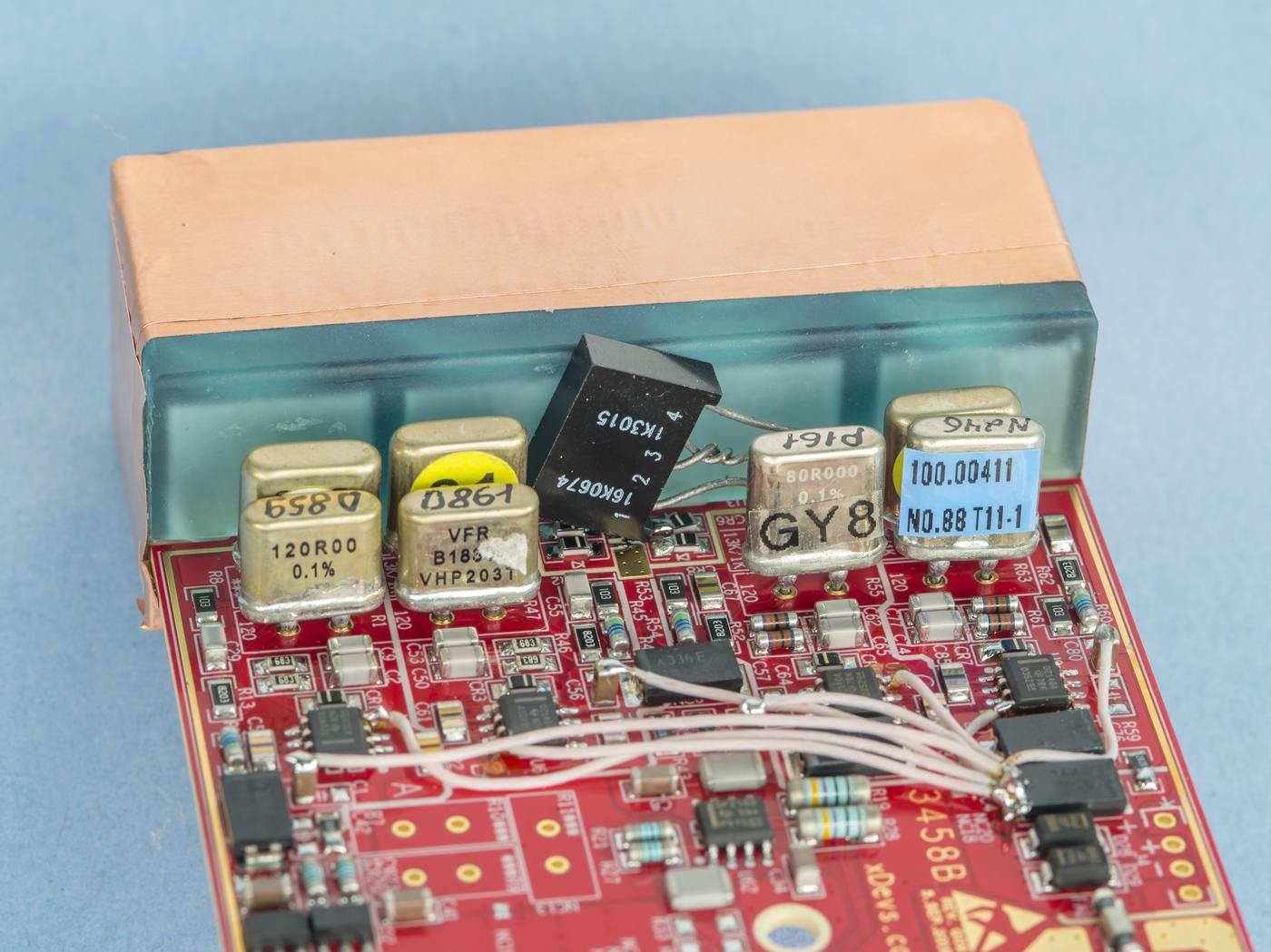Total number of devices evaluated in secondary medium-term drift test shown in list below. All chips are populated on same PCBA and powered by same regulator. They are monitored by same zener array and automated method used for long-term measurement.
- 1 x ADR1000AHZ manufactured with date code 39 week 2018
- 1 x ADR1000AHZ manufactured with date code 33 week 2023
- 1 x LTZ1000ACH manufactured with date code 34 week 2022
- 1 x LTZ1000CH manufactured with date code 28 week 2021
Chips were soldered on xDevs.com QVR reference module replicating ADR1000/LTZ1000A circuit from datasheet. Raw 6.62/7.x V output signal routed to the output or to the bipolar output gain stage on PCB using kelvin connection. Each unit is assembled and enclosed in metal enclosure for shielding and protection purposes. PCBA is mounted with flexible padding to avoid transfer of mechanical stress of vibration from the exterior instrumentation and environment.
No magical special aging was performed on any of the chips. They sat on the shelf unused for some time and now just soldered on the board fresh.
| Parameter | Cell A | Cell B | Cell C | Cell D |
|---|---|---|---|---|
| Zener type | LTZ1000CH | LTZ1000ACH | ADR1000AHZ | ADR1000AHZ |
| Date code | 2128 | 2234 | 2333 | 1839 |
| Temp setpoint | 13 kΩ / 1 kΩ VHD200 | 13 kΩ / 1 kΩ VHD200 | 16.0674 kΩ / 1.3015 kΩ | 13 kΩ / 1 kΩ VHD200 |
| Iz set resistor | 120 Ω VHP203T | 120 Ω VHP203T | 80 Ω VHP202T | 100 Ω VHP202T |
| Temp point voltage, V | 0.506 | 0.511 | 0.495 | 0.472 |
| Iz voltage, measured V | 0.4240 | 0.429 | 0.4846 | 0.4734 |
| Iz current, calculated | 3.53 mA | 3.57 mA | 6.06 mA | 4.73 mA |
| Opamp | TI OPA2140 | TI OPA2140 | TI OPA2140 | TI OPA2140 |
| Q1 resistor | Susumu 68 kΩ | Susumu 68 kΩ | MELF 62 kΩ | MELF 62 kΩ |
| Q2 resistor | Susumu 68 kΩ | Susumu 68 kΩ | MELF 62 kΩ | MELF 62 kΩ |
| FB capacitors | 0.15 uF 1206 film | 0.15 uF 1206 film | 0.15 uF 1206 film | 0.15 uF 1206 film |
| Noise, 0.1 Hz - 10 Hz | 895 nV pk-pk | 957 nV pk-pk | 367 nV pk-pk | 410 nV pk-pk |
| Calculated temperature | +50 °C | +55 °C | +65 °C | +75 °C |
| Compensation resistor | 150 kΩ | 820 kΩ | 500 kΩ | 820 kΩ |
| Measured final α | -0.0203 µV/V/°C | +0.0067 µV/V/°C | -0.052 µV/V/°C | -0.0166 µV/V/°C |
| Measured final β | +0.0014 µV/V/°C | +0.0010 µV/V/°C | +0.0035 µV/V/°C | +0.0004 µV/V/°C |
| Measured ZTC temp, °C | +30.1 °C | +19.5 °C | +30.6 °C | +42.7 °C |
| Output voltage, FEB.13.2024 | 7.17232133 V | 7.09003609 V | 6.60987871 V | 6.62218042 V |
Averaging of zener outputs is also unused (Z6 network is not populated), as only individual zener IC outputs will be monitored from this module.
After running reference powered up for total 700 hours (first 140.5 hours are omitted from plot, "zero" reference taken on 19 February, 2024) drift difference between different chips is quite noticeable.
Both LTZ1000CH and LTZ1000ACH demonstrate clear absence of any significant drift, which underline excellent performance of LTZ design once again. All we can see on LTZ outputs is just residual temperature coefficient play and random noise walk up and down. Worst outlier points for these chips staying within ±0.4 µV/V from initial point on 19 February, 2024.
ADR1000 chips however are not so stable and have significant drift. Newer 33 week 2023 chip which is running at +65 °C oven setpoint demonstrated upward +2.0 µV/V drift in first 8 days from zero point and then somewhat stabilized with walk around ±0.3 µV/V. Older 2018 week 39 chip running at hotter +75 °C (as datasheet recommends to us) and demonstrate opposite drift of -4.2 µV/V and still going. There is no visible stabilization time for this chip, just like with other 1839 chips from older module we explored in long-term drift study page.
Based on this time frame conclusion is:
- LTZ1000-based solutions already able to stabilize in time period less than 140 hours after assembly.
- New year 2023 week 33 ADR1000 chip shows promising stabilization time, more into future will determine if this statement holds.
- Old year 2018 week 39 ADR1000 chip does not stabilize in 700 hours timeframe after assembly.
This time I've added some processing to cancel out systematic short-term errors from the measurement setup equipment in the zener array. This resulted in much nicer data set without much of noisy jumps due to temperature changes in the room. Overall behaviour of the references remained the same. LTZ-based cells wiggle very close to 0.0 µV/V level, essentially staying stable since first 141 hours. ADR that runs at higher temperature continued it's down-ward drift, while ADR1000 at +65 °C also started to drift down after spending a week at +2.2 µV/V level.
- Forum page about ADR1000-based references - branadic and Andreas also demonstrated long-term drift by ADR1000 with similar behavior, despite completely different instrumentation approach.





